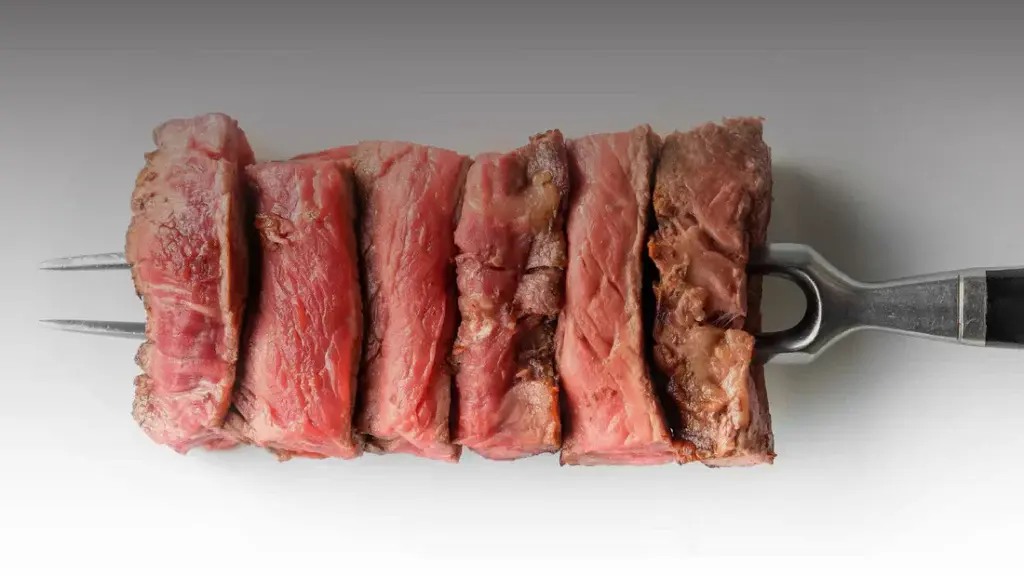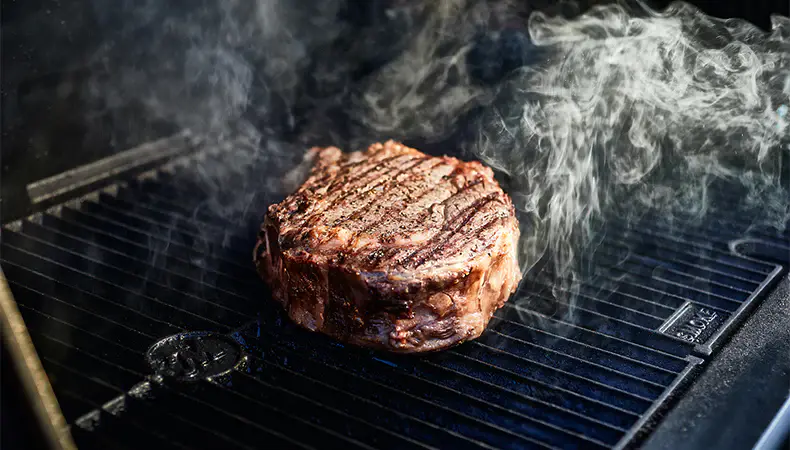Understanding Steak Temperature Basics from Chef Sasha “Fillet” Restaurant Tashkent
The journey to a perfect steak begins with understanding the pivotal role of temperature. Not just a matter of personal preference, the temperature at which a steak is cooked significantly affects its flavor, texture, and overall dining experience. Whether you prefer a tender rare or a fully-cooked well-done, each level of doneness has its unique characteristics and cooking requirements.

The importance of steak temperature for flavor and texture
The temperature of your steak can make or break your meal. Cooking steak at the right temperature ensures that the proteins are tender, the fats are rendered, and the juices are preserved, leading to a flavorful and succulent bite every time.
Overview of different steak temperature levels (rare, medium-rare, medium, medium-well, well-done)
– Rare (120-130°F): A cool red center, soft to touch, with lots of juices.
– Medium Rare (130-135°F): Warm red center, slightly firmer, the most popular choice for its balance of tenderness and flavor.
– Medium (135-145°F): Warm pink throughout, firmer texture, less juicy.
– Medium Well (145-155°F): Slight hint of pink in the center, much firmer, less juice.
– Well Done (above 160°F): No pink, firm, might be slightly dry unless cooked perfectly.
How to choose the right temperature for your taste
Choosing the right steak temperature is about matching your texture and flavor preferences with the right heat levels. While some diners love the tender, juicy nature of a rare steak, others might prefer the firmer, more cooked texture of a medium or well-done piece.
Tools You Need to Measure Steak Temperature
Accurately measuring the internal temperature of your steak is crucial to achieving your desired level of doneness. This section will guide you through the tools and techniques needed to cook your steak perfectly every time.
Introduction to meat thermometers and their types
A reliable meat thermometer is a must-have in any steak lover’s kitchen. Types of meat thermometers include:
– Instant-read thermometers: Provide a quick reading and are ideal for steaks.
– Dial thermometers: Traditional and economical, but slower to read.
– Digital probe thermometers: These can be left in the meat while it cooks, allowing for continuous monitoring.
Tips on how to properly use a meat thermometer
– Insert the thermometer into the thickest part of the steak, avoiding fat and bone.
– Wait for the thermometer to give a stable reading before deciding if your steak is done.
– Clean your thermometer after each use to ensure accuracy and hygiene.
Alternative methods to check steak temperature without a thermometer
If you don’t have a thermometer, you can use the tactile method, comparing the firmness of your steak to different parts of your hand, or visual cues like the amount of juice being released.
Step-by-Step Guide to Cooking the Perfect Rare Steak by Chef Sasha
Cooking a perfect rare steak involves careful preparation and timing. Chef Sasha from “Fillet” Restaurant in Tashkent shares his expert technique for a steak that’s tender and juicy with a cool red center.
Prepping your steak for cooking
– Bring your steak to room temperature before cooking to ensure even heating.
– Season well with salt and pepper, and consider a light brushing of oil to promote even cooking and prevent sticking.

Optimal cooking techniques for achieving a rare steak
– Use high heat to sear the outside quickly while keeping the inside rare.
– Cook each side for only a few minutes, depending on the thickness of your steak.
– Use a cast-iron skillet or grill for the best results.
Visual and tactile cues for identifying a rare steak
– A rare steak will feel soft to the touch, similar to the feel of your cheek.
– Look for a slight char on the outside, but the steak should be very soft in the center.
Tips for Cooking Steaks at Different Temperatures
Achieving the perfect doneness for a variety of tastes requires adjustments in cooking time and technique. Here’s how to tailor your approach for different levels of doneness, along with tips to avoid common mistakes.
Adjusting cooking times for different levels of doneness
– Increase cooking time slightly for each level of doneness from rare to well-done.
– Monitor closely, as the difference between rare and medium-rare can be a matter of minutes.
Common mistakes to avoid when cooking steaks
– Avoid moving the steak too often; let it form a good crust.
– Don’t cut into the steak to check doneness; this can release juices and dry out your meat.
– Make sure your pan or grill is hot enough before you start cooking.
The role of resting steak after cooking and how it affects temperature
– Allow your steak to rest for at least half its cooking time to redistribute juices and finish cooking internally without direct heat.
The Science Behind Steak Temperatures
Understanding the science behind cooking can enhance your culinary skills and lead to better results in the kitchen. This section explores how chemical reactions between amino acids and reducing sugars bring out the flavors and textures we love in a well-cooked steak.
Explanation of Maillard reaction and its impact on steak flavor
The Maillard reaction is a chemical interaction between amino acids and sugars in food, occurring under heat, which creates complex flavors and a desirable crust on your steak.
How different temperatures affect steak texture and juiciness
Higher cooking temperatures can cause the proteins in steak to tighten, squeezing out moisture and resulting in a drier texture. Managing heat is key to maintaining juiciness while achieving a good external crust.
The role of marbling and fat content in achieving the perfect steak
Marbling refers to the white flecks of fat within the meat. These fats melt during cooking, basting the steak from the inside, which helps to enhance flavor and maintain juiciness.
Enhancing Your Steak Experience
Beyond just cooking your steak, enhancing its flavor and presentation can transform a simple meal into a gourmet experience. Here are some tips for pairing, plating, and enjoying your steak.
Pairing sauces and sides that complement steak at various temperatures
– For rare to medium-rare steaks: Choose lighter sauces like béarnaise or a red wine reduction. Pair with sides like garlic mashed potatoes or grilled asparagus.
– For medium to well-done steaks: Richer sauces like mushroom or peppercorn work well. Hearty sides like roasted root vegetables or creamed spinach can stand up to these flavors.
Recommended beverages to enjoy with your steak
– Red wines: Cabernet Sauvignon, Merlot, or Shiraz pair beautifully with beef.
– Whiskey or bourbon: These spirits can complement the richness of the steak.
Tips for plating and presentation to elevate your steak dining experience
– Serve steak on a warm plate to keep it hot.
– Garnish with fresh herbs like rosemary or thyme for a touch of elegance.
– Drizzle with a bit of high-quality olive oil before serving to add sheen and flavor.
Frequently Asked Questions About Steak Temperatures
Here we address some of the most common questions and concerns regarding steak temperatures, offering solutions and additional resources.
- Addressing common queries about steak temperatures and cooking
– Q: How do I prevent my steak from becoming too dry?
– A: Ensure not to overcook and let it rest properly. Consider using a marinade or baste to add moisture.
– Q: Can I cook a frozen steak?
– A: Yes, but allow extra cooking time. For best results, thaw your steak in the fridge overnight before cooking.
– Q: How do I achieve a good sear without overcooking the inside?**
– A: Use high heat for a short time to sear the outside, then lower the heat to finish cooking at your desired doneness.
- Troubleshooting tips for achieving the perfect steak temperature
– If your steak is cooking too quickly on the outside: Lower the heat and consider finishing in the oven.
– If your steak isn’t developing a good sear: Make sure your pan is hot enough and that the steak is dry before it hits the pan.
- Resources for further learning and mastering steak cooking
– Online culinary courses focusing on meat cooking techniques.
– Books and videos by renowned chefs like Gordon Ramsay or Thomas Keller.
This comprehensive guide to steak temperatures not only equips you with the knowledge and tools to cook your perfect steak but also enhances your overall culinary skills, making each meal an experience to savor. Whether you’re a beginner or an experienced cook, mastering the art of steak temperatures is a rewarding endeavor that pays off in every delicious bite. Enjoy the journey and the tastes you’ll discover along the way!

